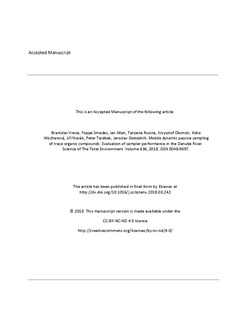| dc.contributor.author | Vrana, Branislav | |
| dc.contributor.author | Smedes, Foppe | |
| dc.contributor.author | Allan, Ian | |
| dc.contributor.author | Rusina, Tatsiana | |
| dc.contributor.author | Okonski, Krzysztof | |
| dc.contributor.author | Hilscherova, Klara | |
| dc.contributor.author | Novak, Jiri | |
| dc.contributor.author | Tarabek, Peter | |
| dc.contributor.author | Slobodnik, Jaroslav | |
| dc.date.accessioned | 2019-11-20T07:32:18Z | |
| dc.date.available | 2019-11-20T07:32:18Z | |
| dc.date.created | 2019-01-16T19:50:37Z | |
| dc.date.issued | 2018 | |
| dc.identifier.citation | Science of the Total Environment. 2018, 636, 1597-1607. | nb_NO |
| dc.identifier.issn | 0048-9697 | |
| dc.identifier.uri | http://hdl.handle.net/11250/2629368 | |
| dc.description | Embargo until 15 September 2020 | nb_NO |
| dc.description.abstract | A “dynamic” passive sampling (DPS) device, consisting of an electrically driven large volume water pumping device coupled to a passive sampler exposure cell, was designed to enhance the sampling rate of trace organic compounds. The purpose of enhancing the sampling rate was to achieve sufficient method sensitivity, when the period available for sampling is limited to a few days. Because the uptake principle in the DPS remains the same as for conventionally-deployed passive samplers, free dissolved concentrations can be derived from the compound uptake using available passive sampler calibration parameters. This was confirmed by good agreement between aqueous concentrations of polycyclic aromatic hydrocarbons (PAHs), polychlorinated biphenyls (PCBs) and hexachlorobenzene (HCB) derived from DPS and conventional caged passive sampler. The DPS device enhanced sampling rates of compounds that are accumulated in samplers under water boundary layer control (WBL) more than five times compared with the conventionally deployed samplers. The DPS device was deployed from a ship cruising downstream the Danube River to provide temporally and spatially integrated concentrations. A DPS-deployed sampler with surface area of 400 cm2 can reach sampling rates up to 83 L d−1. The comparison of three passive samplers made of different sorbents and co-deployed in the DPS device, namely silicone rubber (SR), low density polyethylene (LDPE) and SDB-RPS Empore™ disks showed a good correlation of surface specific uptake for compounds that were sampled integratively during the entire exposure period. This provided a good basis for a cross-calibration between the samplers. The good correlation of free dissolved PAHs, PCBs and HCB concentration estimates obtained using SR and LDPE confirmed that both samplers are suitable for the identification of concentration gradients and trends in the water column. We showed that the differences in calculated aqueous concentrations between sampler types are mainly associated with different applied uptake models. | nb_NO |
| dc.language.iso | eng | nb_NO |
| dc.publisher | Elsevier | nb_NO |
| dc.rights | Attribution-NonCommercial-NoDerivatives 4.0 Internasjonal | * |
| dc.rights.uri | http://creativecommons.org/licenses/by-nc-nd/4.0/deed.no | * |
| dc.title | Mobile dynamic passive sampling of trace organic compounds: Evaluation of sampler performance in the Danube River | nb_NO |
| dc.type | Journal article | nb_NO |
| dc.type | Peer reviewed | nb_NO |
| dc.description.version | acceptedVersion | nb_NO |
| dc.source.pagenumber | 1597-1607 | nb_NO |
| dc.source.volume | 636 | nb_NO |
| dc.source.journal | Science of the Total Environment | nb_NO |
| dc.identifier.doi | 10.1016/j.scitotenv.2018.03.242 | |
| dc.identifier.cristin | 1658744 | |
| dc.relation.project | Norges forskningsråd: 160016 | nb_NO |
| dc.relation.project | EC/FP7/603437 | nb_NO |
| cristin.unitcode | 7464,30,21,0 | |
| cristin.unitname | Miljøkjemi | |
| cristin.ispublished | true | |
| cristin.fulltext | postprint | |
| cristin.qualitycode | 2 | |

